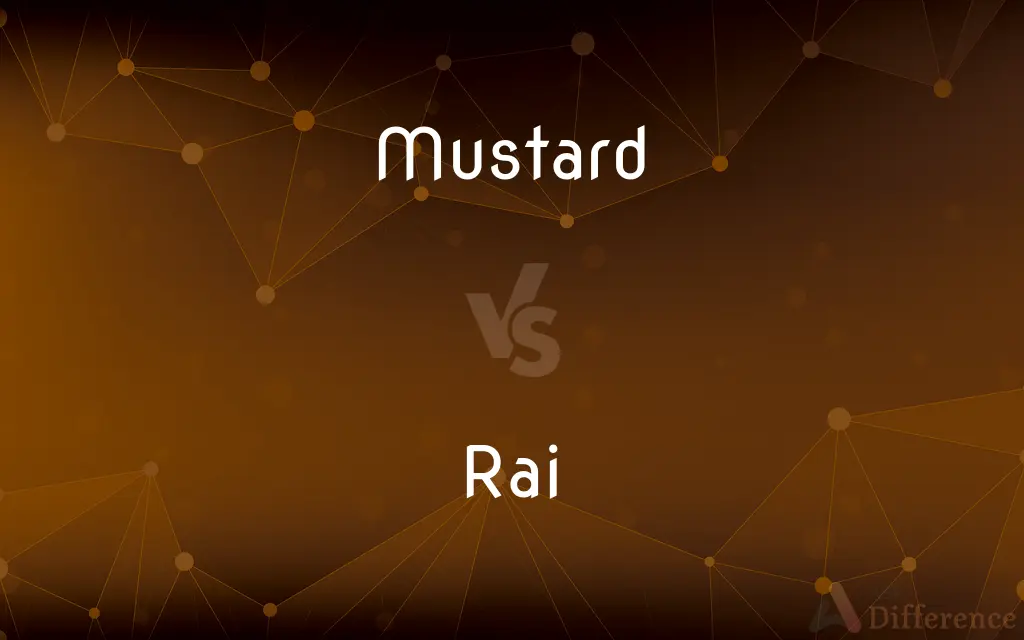Mustard vs. Rai — What's the Difference?
By Tayyaba Rehman & Fiza Rafique — Updated on April 18, 2024
Mustard is primarily known as a condiment made from the seeds of the mustard plant, while Rai specifically refers to black mustard seeds used in Indian cooking.

Difference Between Mustard and Rai
Table of Contents
ADVERTISEMENT
Key Differences
Mustard, in a broader context, encompasses various forms including seeds, powder, and prepared sauces used globally in culinary applications, while Rai, or black mustard seeds, are a specific type predominantly used in Indian cuisines for tempering dishes. Both are products of the mustard plant but utilized differently based on culinary traditions.
Mustard seeds are available in several varieties such as yellow, brown, and black, each with distinct flavors, while Rai specifically refers to the black variety, known for its strong, pungent flavor which is highly valued in South Asian cooking. This highlights the regional preferences and culinary applications that differentiate mustard seed uses.
In Western cuisines, mustard is often prepared as a condiment, either in a smooth or whole-seed form, commonly used as a spread or dip, while Rai is typically used whole or cracked in hot oil to release flavor before adding other ingredients. This method of using Rai is crucial in many Indian recipes, creating a base of flavor.
Mustard, particularly in the form of pastes or sauces, often incorporates vinegar, wine, or other liquids, creating a range of flavors from sweet to spicy, whereas Rai’s flavor profile is predominantly sharp and more intensely spicy, reflecting its unaltered form as seeds.
Health-wise, both mustard in general and Rai specifically, offer benefits such as anti-inflammatory properties and nutritional content like omega-3 fatty acids, though Rai is often noted for its more potent medicinal properties, which have been recognized in Ayurvedic practices.
ADVERTISEMENT
Comparison Chart
Type
Seeds, powder, or prepared sauce
Seeds (specifically black)
Culinary Use
Condiment, flavoring in dishes
Flavor enhancer, tempering in dishes
Flavor
Varies from mild to spicy
Strong and pungent
Common in Cuisine
Global, especially Western
Indian
Health Benefits
Anti-inflammatory, contains omega-3s
Potent medicinal properties
Compare with Definitions
Mustard
Mustard is a popular condiment made from mustard seeds.
He spread mustard on his sandwich.
Rai
Rai are the small, black seeds of the mustard plant.
Rai should be stored in a cool, dry place.
Mustard
Ground mustard is used as a spice in various recipes.
She added mustard to the marinade for extra flavor.
Rai
Rai is essential in many Indian recipes.
Rai was tempered in oil for the curry.
Mustard
Mustard plants are also grown for their leaves.
Mustard greens are a nutritious addition to salads.
Rai
Rai is cracked or fried to release flavor.
Rai was fried until it popped in the pan.
Mustard
Mustard is known for its medicinal properties.
Mustard plasters are historically used to treat chest congestion.
Rai
Rai is known for its strong pungency.
The pungency of rai enhances the dish’s flavor.
Mustard
Mustard varies from sweet to spicy.
I prefer a milder mustard in my dishes.
Rai
Rai is used in Ayurvedic medicine.
Rai is considered beneficial for digestive health.
Mustard
A hot-tasting yellow or brown paste made from the crushed seeds of certain plants, typically eaten with meat or used as a cooking ingredient
Dijon mustard
Mustard sauce
Rai
A form of popular Algerian music combining traditional Arabic vocal styles with various elements of popular Western music and featuring outspoken, often controversial lyrics.
Mustard
The yellow-flowered Eurasian plant of the cabbage family whose seeds are used to make mustard.
Rai
Stone money
Mustard
A brownish yellow colour
A mustard sweater
Mustard
Any of various Eurasian plants of the mustard family, especially white mustard, Indian mustard, and black mustard, which are cultivated for their pungent seeds and edible leaves.
Mustard
A condiment made from the powdered seeds of certain of these plants.
Mustard
A member of the mustard family.
Mustard
A dark yellow to light olive brown.
Mustard
Any of a group of toxic organic compounds that include mustard gas and the nitrogen mustards.
Mustard
A plant of certain species of the genus Brassica, or of related genera (especially Sinapis alba, in the family Brassicaceae, with yellow flowers, and linear seed pods).
Mustard
Powder or paste made from seeds of the mustard plant, and used as a condiment or a spice.
When the waitress brought the food, I asked whether she had any Dijon mustard.
Mustard
The leaves of the mustard plant, used as a salad.
Mustard and cress sandwiches.
Mustard
Dark yellow colour, the colour of mustard.
Mustard
One of a family of vesicants containing one or more 2-chloroethyl (C2H4Cl) groups, commonly used in chemical warfare and cancer chemotherapy.
Mustard
The tomalley of a crab, which resembles the condiment.
Mustard
Of a dark yellow colour.
Mustard
The name of several cruciferous plants of the genus Brassica (formerly Sinapis), as white mustard (Brassica alba), black mustard (Brassica Nigra), wild mustard or charlock (Brassica Sinapistrum).
Mustard
A powder or a paste made from the seeds of black or white mustard, used as a condiment and a rubefacient. Taken internally it is stimulant and diuretic, and in large doses is emetic.
Mustard
Any of several cruciferous plants of the genus Brassica
Mustard
Pungent powder or paste prepared from ground mustard seeds
Mustard
Leaves eaten as cooked greens
Common Curiosities
What dishes is Rai used in?
Rai is commonly used in Indian cooking, especially for tempering dishes.
How does the flavor of mustard compare to Rai?
Mustard flavor can range from sweet to spicy, whereas Rai is notably more pungent and intense.
Is Rai good for health?
Yes, Rai has recognized health benefits, especially noted in Ayurvedic medicine for its digestive and anti-inflammatory properties.
What are the different types of mustard seeds?
Mustard seeds come in yellow, brown, and black varieties, each with unique flavors.
Are there any specific benefits of mustard in cooking?
Mustard adds flavor and has health benefits such as anti-inflammatory properties.
Is mustard available in forms other than seeds?
Yes, mustard is available as seeds, powder, and prepared as a condiment sauce.
Can mustard seeds be used in place of Rai?
While they can be substituted, the flavor profiles are quite different, with Rai being stronger.
What makes Rai distinct in Indian cuisine?
Rai's strong flavor is integral to the characteristic taste of many Indian dishes.
What are mustard greens?
Mustard greens are the leaves of the mustard plant, eaten as a vegetable.
What is mustard used for?
Mustard is used as a condiment, spice, and in medicinal applications.
How does the medicinal use of mustard compare to Rai?
Both have medicinal uses, but Rai is particularly valued in Ayurveda for its potent properties.
Can Rai be used in non-Indian recipes?
Yes, Rai can be experimented with in various global cuisines, though its strong flavor may dominate.
How are mustard seeds used in Western cooking?
In Western cuisine, mustard seeds are often ground into powder or made into a sauce.
What is the best way to store Rai?
Rai should be stored in a cool, dry place to maintain its flavor and longevity.
How is Rai typically prepared in Indian recipes?
Rai is usually heated in oil until it begins to pop, which releases its flavor.
Share Your Discovery

Previous Comparison
Tourist vs. Visitor
Next Comparison
Honor vs. ChivalryAuthor Spotlight
Written by
Tayyaba RehmanTayyaba Rehman is a distinguished writer, currently serving as a primary contributor to askdifference.com. As a researcher in semantics and etymology, Tayyaba's passion for the complexity of languages and their distinctions has found a perfect home on the platform. Tayyaba delves into the intricacies of language, distinguishing between commonly confused words and phrases, thereby providing clarity for readers worldwide.
Co-written by
Fiza RafiqueFiza Rafique is a skilled content writer at AskDifference.com, where she meticulously refines and enhances written pieces. Drawing from her vast editorial expertise, Fiza ensures clarity, accuracy, and precision in every article. Passionate about language, she continually seeks to elevate the quality of content for readers worldwide.














































